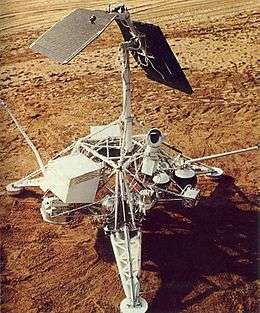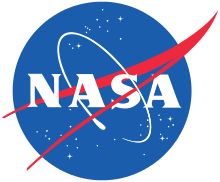Surveyor 4
 Surveyor model on Earth | |
| Mission type | Lunar lander |
|---|---|
| Operator | NASA |
| COSPAR ID | 1967-068A |
| SATCAT № | 02875 |
| Mission duration |
65 hours Failed to land |
| Spacecraft properties | |
| Manufacturer | Hughes Aircraft |
| Dry mass | 282 kilograms (622 lb) |
| Start of mission | |
| Launch date | July 14, 1967, 11:53:29 UTC |
| Rocket | Atlas LV-3C Centaur-D |
| Launch site | Cape Canaveral LC-36A |
| End of mission | |
| Last contact | 17 July 1967, 02:02:30 UTC (approx) |
| Lunar impact (failed landing) | |
| Impact date | July 17, 1967, 02:05:00 UTC |
| Impact site | 0°27′N 1°23′W / 0.45°N 1.39°W |
Surveyor 4 was the fourth lunar lander in the American unmanned Surveyor program sent to explore the surface of the Moon. This spacecraft crashed after an otherwise flawless mission; telemetry contact was lost 2.5 minutes before touchdown. The planned landing target was Sinus Medii (Central Bay) at 0.4° north latitude and 1.33° west longitude.
Equipment
This spacecraft was the fourth in a series designed to achieve a soft landing on the Moon and to return photography of the lunar surface for determining characteristics of the lunar terrain for Apollo lunar landing missions. Equipment on board included a television camera and auxiliary mirrors, a soil mechanics surface sampler, strain gauges on the spacecraft landing legs, and numerous engineering sensors. Like Surveyor 3, Surveyor 4 was also equipped with a surface claw (with a magnet in the claw) to detect and measure ferrous elements in the lunar surface.
After a flawless flight to the Moon, radio signals from the spacecraft ceased during the terminal-descent phase at 02:03 UT on 17 July 1967, approximately 2.5 minutes before touchdown. Contact with the spacecraft was never reestablished, and the mission was unsuccessful. The solid-fuel retrorocket may have exploded near the end of its scheduled burn.
